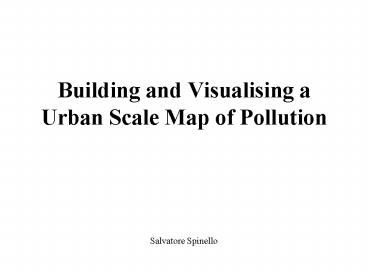Building and Visualising a Urban Scale Map of Pollution PowerPoint PPT Presentation
1 / 8
Title: Building and Visualising a Urban Scale Map of Pollution
1
Building and Visualising a Urban Scale Map of
Pollution
Salvatore Spinello
2
Static Data Sources Ordnance Survey
Land-Line.Plus
N
- Land-Line.Plus digital map data is digitised from
Ordnance Survey Large Scales maps and surveys
which show the accurately surveyed positions of
the natural and man-made features of the
topography. - The data includes outlines and divisions of
buildings, land parcel boundaries, road kerbs,
rivers and water features. - It is derived from three source scales of mapping
- Urban (11,250 scale) - major towns and cities
- Rural (12,500 scale) - smaller towns, villages
and developed rural areas - Moorland (110,000 scale) - mountain and moorland
areas
500 m
E
500 m
3
3D Reconstruction of an area around St.Paul
Cathedral.
Buildings, streets, pavements, water and parks
are recognised and triangulated with a
Constrained Delaunay approach. The height values
of the buildings are proportional to their area.
4
A more detailed model (from AutoCAD or 3D Studio)
can be easily imported using the global
coordinates of the Ordnance Survey
5
Some texture can be added to increase the reality
of the model.
Aerial photograph one pixel per one square meter
6
THE AIR POLLUTION DATA LAYER The air pollution
data is collected from various monitoring
stations in London which are archived by central
government as hourly averages for all pollutants.
Camden Kerbside Nitrogen Dioxide GMT,
1, 2, 3, 4, 5, 6, 7, 8, 9,
10, 11, 12, 13, 14, 15, 16, 17, 18, 19, 20, 21,
22, 23, 24,, Max, Ave. 01/01/02, 46, 46, 48,
47, 42, 40, 40, 48, 51, 54, 57, 70, 64, 59, 50,
50, 57, 47, 47, 46, 46, 44, 42, 43,, 70, 49.
THE AIR POLLUTION MODEL Inverse Distance
Weighting (IDW) has been chosen to produce the
model
R ? Zp dp-n P1
Zp pollution at the known point p dp distance
between point p and point x
Zx
R ? dp-n P1
7
We are focusing on London to start to build novel
visualisations of pollution that take into
account the actual urban structure.
Pollution values are displayed on a map with
points of high pollution displayed as dark grey
levels and lower pollution as light grey level.
Position of the static stations that give the
input values to construct the model
The height of the blue lines gives the confidence
of the approximated value (distance from the
nearest Station).
8
Future Work
- Improving the model putting suitable façade and
adding objects to create a more realistic city. - Augmenting the main database, made with the
pollution readings from static sensors, with
temporal, noisy data captured from a mobile
sensor.

